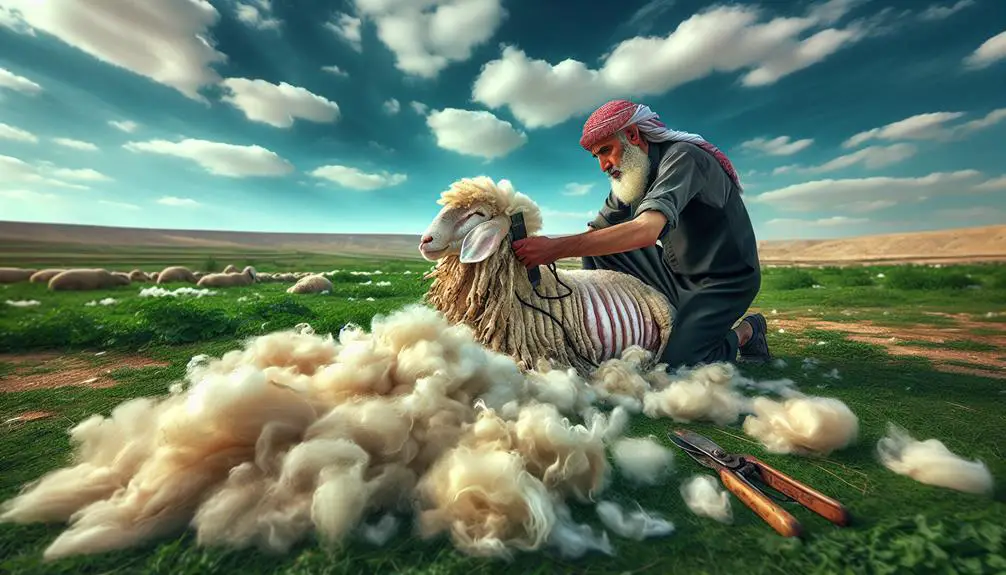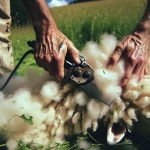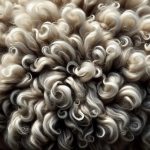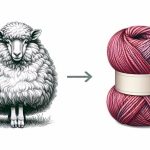I just want to share that wool is a natural fiber mainly from sheep, but goats, rabbits, llamas, and alpacas also produce it. Each animal contributes with unique qualities, allowing for a wide textile range.
Table of Contents
Key Takeaways
- Wool comes from animals like sheep, goats, rabbits, camels, llamas, and alpacas.
- Different sheep breeds offer wool with diverse textures, from fine to coarse.
- Angora rabbits provide silky, soft wool fibers highly valued in textiles.
- Wool from various animals caters to different needs, making it a sustainable choice.
- Wool is a versatile fiber sourced from a variety of animals for different textile applications.
Origins of Wool Fiber
Wool fiber originates from various animals such as sheep, goats, rabbits, camels, llamas, and alpacas. Among these, Merino wool, sourced from Merino sheep, stands out for its exceptional softness and quality due to its fine wool fibers. Different sheep breeds produce wool with diverse textures, ranging from fine to coarse, offering a wide array of options for various applications.
Additionally, Angora rabbits are another source of wool known for their silky, soft fibers, highly valued in the textile industry. Each of these wool-producing animals contributes uniquely textured fibers that cater to different needs and preferences, making wool a versatile and sustainable choice in the domain of natural fibers.
The protein keratin, found in wool, not only enhances its durability but also underscores its environmentally friendly nature, aligning with the growing demand for eco-conscious and renewable materials in today's textile landscape.
Wool-Producing Animal Species
Hailing from various species, wool is a versatile fiber cherished for its diverse textures and unique properties in the textile industry. Wool is produced by a variety of animals, each offering distinct qualities:
- Sheep: Sheep are the primary source of wool, providing fine, medium, and coarse wool types used for different textile applications.
- Angora Rabbit: Angora rabbits are raised for their soft wool, ideal for making luxurious sweaters and accessories.
- Cashmere Goats: Cashmere goats yield wool fibers known as cashmere, prized for their softness and warmth in high-end garments.
- Llamas: Specifically alpacas, llamas produce fine wool without guard hairs, sought after for its silky feel and insulating properties.
These animals play an essential role in the production of wool, each contributing unique characteristics that cater to various needs in the fashion and textile markets.
Sheep: Primary Wool Source
Sheep are essential for wool production, providing fibers necessary for textiles.
The quality of wool depends on factors like sheep breed and care practices.
Sustainable sheep farming is important for maintaining a steady supply of wool.
Sheep Wool Production
With their high-quality fibers, sheep stand out as the primary source for wool production in the textile industry. When it comes to sheep wool production, several key points are worth noting:
- Sheep produce wool of varying qualities, with some breeds like the Merino known for their fine wool.
- The wool is primarily composed of keratin, a protein that gives it durability and versatility.
- Different wool breeds yield fibers categorized as fine, medium, or coarse, based on specific characteristics.
- Australia leads global wool production, with Merino wool being particularly sought after for its exceptional quality and softness.
Wool Quality Factors
Merino sheep, renowned for their fine wool quality, contribute greatly to the factors that determine the overall quality of wool in the textile industry. Factors such as the breed of sheep, climate, and diet play essential roles in determining wool quality. Additionally, characteristics like the crimp pattern and staple length of wool fibers impact the strength and durability of the wool. Wool quality is often classified into fine, medium, and coarse types based on fiber characteristics. The fine wool produced by Merino sheep is highly valued for its softness, warmth, and versatility in various textile applications.
| Factors Influencing Wool Quality | Examples |
|---|---|
| Breed of Sheep | Merino sheep |
| Climate | Temperate regions |
| Diet | High-quality nutrition |
Sustainable Sheep Farming
Sustainable farming practices are crucial for guaranteeing the responsible management of land and the welfare of animals, particularly in the production of wool, a valuable and versatile fiber.
- Sheep farming promotes biodiversity by maintaining a balanced ecosystem.
- Proper land management techniques help safeguard soil health and fertility.
- Ethical treatment of sheep guarantees their well-being and sustainable wool production.
- Conservation of natural resources, such as water and pastureland, is a priority in sustainable sheep farming.
Goats and Their Wool
Goats, especially Angora and Cashmere breeds, are valued for their high-quality wool used in luxury garments. Mohair comes from the Angora goat, and it's prized for its softness and sheen. These goats can produce around 5.3 pounds of mohair per shearing, which is quite a lot of wool!
On the other hand, Cashmere goats give us cashmere wool. Cashmere is super soft and expensive because it takes a lot of effort to shear these goats. They yield up to 2.5 pounds of cashmere per shearing, making each fiber precious.
Angora goat wool is often used in making luxurious sweaters and other high-end clothing. Cashmere wool, being extremely soft, is also highly sought after. Both Angora and Cashmere goats play an important role in the textile industry by providing excellent wool for various purposes. These goats are truly special in the world of wool production.
Llamas in Wool Production
Often overlooked in discussions about wool production, llamas play a noteworthy role in providing coarser wool with guard hairs, which is valued for its durability in various products. Llamas are essential in the domain of wool production for their unique fiber characteristics. Here's why:
- Llamas, unlike alpacas, have coarser wool with guard hairs, making it ideal for durable goods like rugs and outerwear.
- A single llama can yield around 6 pounds of wool per shearing, contributing considerably to fiber production.
- The versatility of llama wool allows it to be utilized in a wide range of products, showcasing the adaptability of fibers from different animals.
- Their wool, though not as fine as alpaca wool, provides a valuable option for those seeking sturdy textiles that can withstand wear and tear.
In the vast landscape of wool production, llamas stand out for their ability to supply robust fibers that cater to the needs of various industries.
Camels and Their Unique Fibers
Camel wool, found in regions like North Africa, the Middle East, and Central Asia, is known for its unique properties and diverse applications in textile production. Camels produce wool once a year, yielding around 20 pounds per shearing. This wool is prized for its exceptional insulating properties, making it ideal for crafting scarves, gloves, jackets, and even traditional items like yurts and carpets in Mongolia.
Major producers of camel wool include Inner Mongolia and China. The wool from camels serves a vital role in providing warmth and comfort in cold climates, thanks to its natural ability to retain heat. The use of camel wool showcases the resourcefulness of utilizing natural fibers for a variety of practical purposes. Its durability and insulation make it a valuable material for creating textiles that can withstand harsh weather conditions while offering a unique and luxurious feel.
Alpaca and Its Luxurious Wool
Alpaca wool, known for its luxurious qualities, offers a softer, warmer, and more sustainable alternative to traditional wool options.
- The fine fibers of alpaca wool create a fabric that's incredibly soft to the touch, making it a delight to wear against the skin.
- Alpaca wool is considered one of the finest natural fibers available, prized for its exceptional softness and warmth.
- The fine nature of alpaca fiber allows for the production of lightweight garments that provide superior insulation without the bulkiness of other materials.
- Alpaca wool's fine texture is highly sought after in the textile industry for its ability to be spun into delicate, luxurious pieces that drape elegantly.
Alpaca wool's reputation for being both soft and fine makes it a top choice for those seeking quality, comfort, and sustainability in their clothing.
Bison: Uncommon Wool Provider
Bison wool, though uncommon in the textile industry, is sought after for its warmth, softness, and durability. It is coarser than sheep's wool, making it ideal for specific uses like felting. Bison wool is harvested during the spring shedding season, when the animals naturally lose their winter coats. This wool is well-suited for harsh weather conditions due to its insulating properties. Blending bison wool with other fibers can result in unique and textured fabrics that cater to various needs.
| Pros | Cons |
|---|---|
| Warmth | Coarser fibers |
| Softness | Limited availability |
| Durability | Less elastic than sheep's wool |
Bison wool, while not as common as other types of wool, offers distinct advantages regarding warmth and durability, especially in extreme weather. Its coarse texture lends itself well to felting projects and unique fabric blends.
Yak Wool: A Rare Find
Yak wool, a rare and luxurious fiber highly valued for its warmth and softness, is a prized material native to the Himalayan region.
- Imagine the vast, snow-capped peaks of the Himalayas where sturdy yaks roam freely, their wool glistening in the crisp mountain air.
- Picture the rich, dark tones of yak wool, exuding a natural elegance and sophistication that sets it apart from other fibers.
- Envision the incredible softness of yak wool against your skin, providing a cozy warmth that feels like a gentle embrace.
- Visualize the strength and durability of yak wool, a material that can withstand the harshest of conditions while maintaining its luxurious texture.
Yak wool isn't just a material; it's a symbol of resilience, comfort, and unparalleled quality. This rare find offers a unique blend of luxury and practicality, making it a treasure worth cherishing in the world of natural fibers.
Other Wool-Producing Creatures
I'll now talk about other animals that produce wool, like alpacas, llamas, and Angora rabbits.
Each of these creatures yields different types of wool used in making various products.
Understanding the unique qualities of wool from these animals adds to the diversity of materials available for different purposes.
Sheep Breeds for Wool
Sheep breeds are the primary source of wool, offering a variety of options for different textile applications. When considering sheep's wool, medium wool breeds are commonly used to produce a range of wool products.
Let's explore some popular sheep breeds known for their wool characteristics:
- Merino: Renowned for its softness and fine quality.
- Rambouillet: Produces high-quality, dense wool suitable for various textiles.
- Targhee: Versatile wool breed ideal for a wide range of wool products.
- Lincoln: Known for its durable and strong wool fibers used in heavy-duty applications.
These sheep breeds showcase the diversity in wool types, catering to different needs in the textile industry.
Alpaca and Llamas
Alpacas and llamas, both camelid animals, are valued for their production of luxurious wool. Alpacas yield soft and fine wool, around 6 pounds per shearing. This wool is popular for spinning and knitting due to its quality. Alpaca wool is highly sought after for its warmth, softness, and hypoallergenic properties.
On the other hand, llamas produce coarser wool with guard hairs mixed in. Unlike alpacas, llamas have guard hairs in their wool, which can affect its texture. Both alpacas and llamas play a significant role in the production of different types of wool, each offering unique characteristics that appeal to different preferences.
Angora Rabbits
Angora rabbits, known for their soft and fluffy wool, are bred specifically for their luxurious fiber production.
- Their wool is so delicate and fine, making it prized for its luxurious feel.
- Angora rabbits can produce around 3 pounds of wool per year, a significant amount for their size.
- The wool from Angora rabbits is commonly used in making sweaters, gloves, and scarves.
- Hand spinners often favor Angora wool due to its softness and warmth.
These rabbits require regular grooming and shearing every 90 days to maintain the quality of their fiber. Additionally, Angora wool can be blended with sheep's wool to enhance the durability of clothing items.
Frequently Asked Questions
What Animal Is Wool?
Wool comes from sheep, making sheep the source of wool. It's a fiber made of keratin, giving it unique qualities. Merino wool, from Merino sheep, is known for its fineness. It's used in cozy apparel for its warmth and breathability.
Which Animal Gives Wool Other Than Sheep?
Alpacas, Angora goats, cashmere goats, Angora rabbits, and llamas all yield wool. It's not just sheep! Each animal's wool has unique qualities, from soft cashmere to fluffy Angora rabbit wool, perfect for various garments and accessories.
Is Wool Only From Sheep?
Wool isn't only from sheep. Various animals like goats, rabbits, llamas, and alpacas also provide wool. Each animal's wool has unique qualities like softness, fineness, and durability. Different breeds offer diverse characteristics for various uses.
Is Wool From Sheep or Goat?
Wool comes from sheep, not goats. Sheep produce high-quality fleece, while goats give mohair and cashmere. Merino wool, a popular type, is from Merino sheep. Wool is keratin found in sheep's fleece.
- How to Get Any Stain Out of Polyamide: A Complete Cleaning Guide - June 30, 2025
- Can You Bleach Polyamide? Why It’s a Bad Idea and What to Do Instead - June 30, 2025
- Can Polyamide Go in the Dryer? The Safest Way to Dry Your Garments - June 30, 2025







